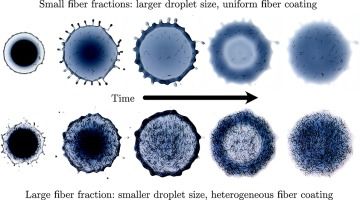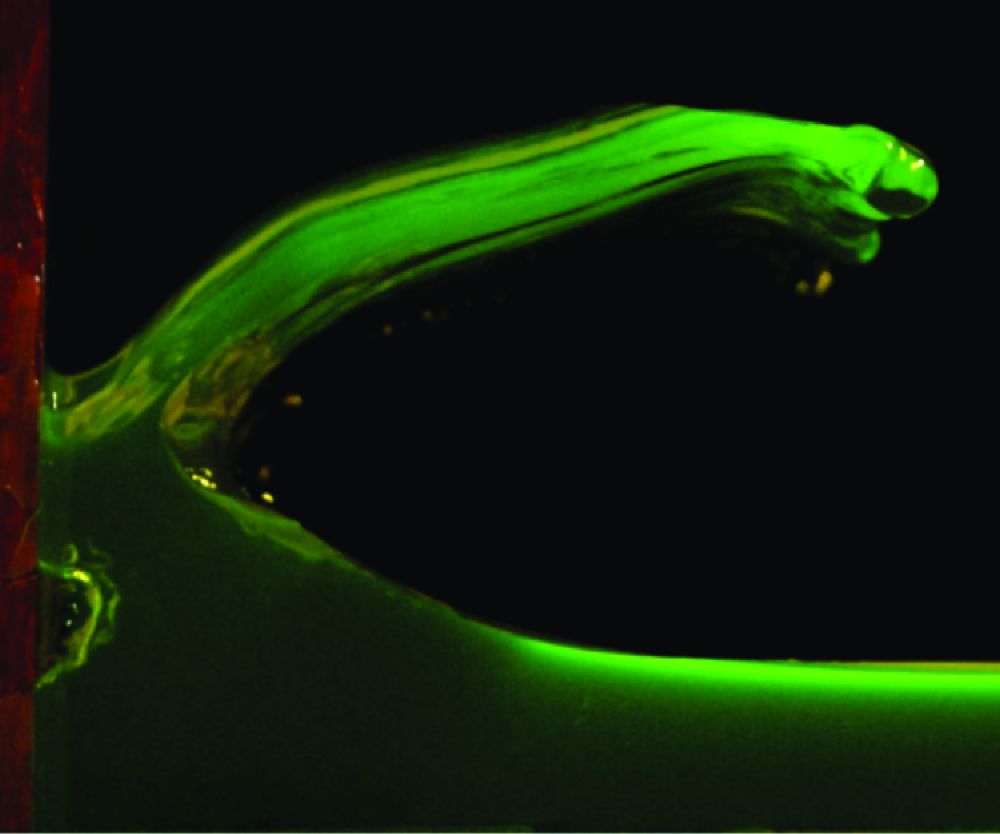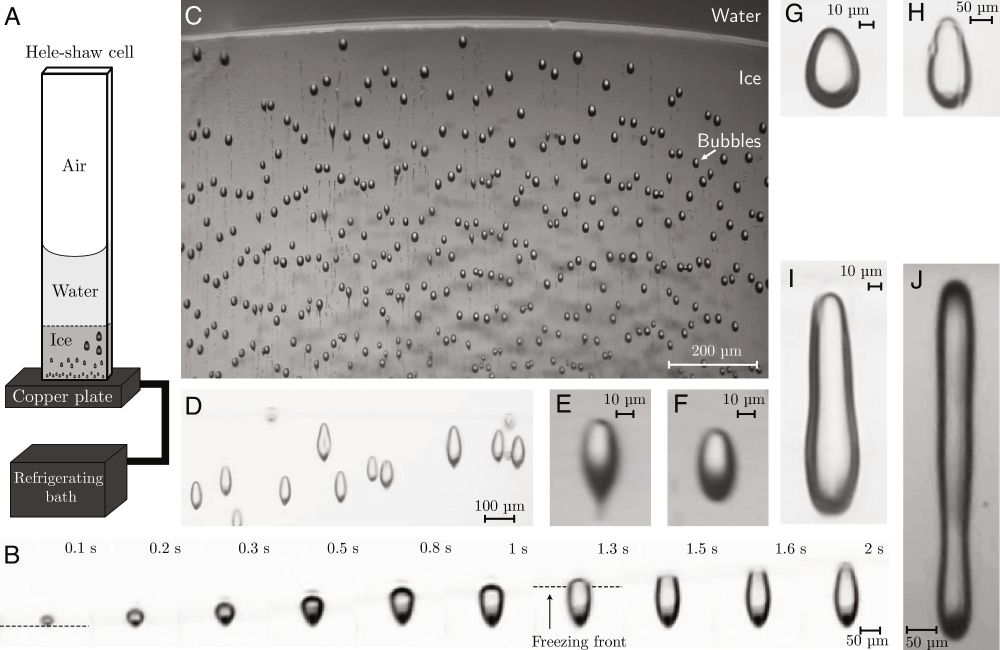We highlight some DIW challenges related to fluid mechanics and soft matter, such as extrudability and clogging, filament stability, post-deposition spreading, slumping, and buckling. Hopefully, it will inspire various fundamental studies in fluid mechanics. (including by us)
07.10.2025 13:43 — 👍 2 🔁 0 💬 0 📌 0

Thrilled that our article in @annualreviews.bsky.social
of Fluid Mechanics is out! “Fluid Mechanics Challenges in Direct‑Ink‑Writing Additive Manufacturing” doi.org/10.1146/annu.... I am grateful to the two co-authors, @raytyler.bsky.social and Brett Compton. @univofmaryland.bsky.social
07.10.2025 13:43 — 👍 3 🔁 1 💬 2 📌 0
Sauret Lands NSF Grant for Sediment Research
UMD faculty member to examine how tiny particles form clusters, fragment, and are transported under water.
New @univofmaryland.bsky.social article about our NSF project on sediment flows with Eckart Meiburg @ucsbengineering.bsky.social me.umd.edu/news/story/s.... Thrilled to see the project featured and excited to get started.
29.09.2025 21:13 — 👍 3 🔁 0 💬 0 📌 0
Take‑home. Very small holes clog; below ~3 grain diameters there’s no flow, and around 3–6 it’s intermittent. Large holes act like dense, fluid‑like jets with a steady rate. This is also why hourglasses keep time so well. @univofmaryland.bsky.social @ucsbengineering.bsky.social [4/4]
19.09.2025 18:28 — 👍 1 🔁 0 💬 0 📌 0

Why openings matter. Near the edge, grains dilate in a thin boundary layer. This boundary layer only extends 10–15 grain diameters, but it changes the discharge rate. Once you account for it, all the data collapse onto a single curve! [3/4]
19.09.2025 18:28 — 👍 2 🔁 0 💬 1 📌 0

What we find. We split the flow rate in two: the speed of the grains and how they pack at the opening. Gravity and the hole size set the speed. Away from the rim, packing settles to a near‑universal “free‑fall” value. We show this with 3D experiments and DEM simulations. [2/4]
19.09.2025 18:28 — 👍 1 🔁 0 💬 1 📌 0

Excited to share our new preprint on the discharge of granular materials from a silo. Led by @ramsudhirsharma.bsky.social , we went after a simple question: What is the flow rate through the opening? The answer turns out to be "simple" and quite general. See more here: arxiv.org/abs/2509.14415 [1/4]
19.09.2025 18:28 — 👍 8 🔁 3 💬 1 📌 0

NSF Graduate Research Fellowship Program (GRFP)
The GRFP lives!! (due end of October)
www.nsf.gov/funding/oppo...
08.09.2025 18:23 — 👍 344 🔁 277 💬 6 📌 18

Excited to share that our NSF PMP project with Eckart Meiburg has been funded! We’ll study cohesive immersed granular flows through experiments and simulations to improve predictions of sediment transport & slurry processing. @univofmaryland.bsky.social @ucsbengineering.bsky.social
29.08.2025 19:42 — 👍 6 🔁 0 💬 0 📌 0
KITP
Check out the @kitp-ucsb.bsky.social conference we're (Vashan Wright, Sujit Datta, Nathalie Vriend) organizing:
www.kitp.ucsb.edu/activities/s... for THIS JANUARY 6-9!
Geoscientists, physicists and engineers: are you intellectually adventurous and been wondering "is this all there is?" 🧪
20.08.2025 14:45 — 👍 7 🔁 8 💬 1 📌 2

Our new study from Joanne Steiner’s PhD work and with C. Morize, P. Gondret, and I. Delbende has just been published in Phys. Rev. Fluids! We study vortex rings generated when a disk moves toward or away from a wall. doi.org/10.1103/ynxr...
14.08.2025 13:47 — 👍 2 🔁 1 💬 0 📌 0

Excited to be an invited speaker in EP018: Geophysical Granular Flows & Sediment Transport at AGU 2025 (Dec 15–19)! I’ll be sharing our results on cohesive granular materials. Many thanks to the organizers!
Abstract submissions open until July 30. agu.confex.com/agu/agu25/pr... @agu.org
20.07.2025 19:08 — 👍 4 🔁 0 💬 0 📌 0

We are grateful to receive funding from the ACS PRF to investigate how fibers and anisotropic particles reorient, bend, and sometimes clog in porous media. From microplastic transport to fiber-laden inks, we aim to uncover the physics behind their transport through experiments and modeling.
26.06.2025 17:41 — 👍 6 🔁 0 💬 0 📌 0
Congrats to all the new Fellows! It’s quite an impressive cohort
12.05.2025 17:56 — 👍 2 🔁 0 💬 0 📌 0
YouTube video by American Physical Society
V0055: Drop impact of fiber suspensions
And a video entry to the Gallery of Fluid Motion at the APS DFD 2023: www.youtube.com/watch?v=V0RJ...
09.04.2025 01:06 — 👍 1 🔁 0 💬 0 📌 0

And bonus: the winning entry from @ramrajesh97 to the Gallery of Soft Matter @apsdsoft.bsky.social last year that shows some cool pictures with fiber suspensions
09.04.2025 01:06 — 👍 1 🔁 0 💬 1 📌 0
Capillary flows of particulate suspensions are already complex, but anisotropic fibers add even more layers of complexity. We are excited to further explore fiber dynamics in various situations. Feedback and suggestions are very welcome!
09.04.2025 01:06 — 👍 0 🔁 0 💬 1 📌 0

#3: Fiber coverage becomes uneven when increasing the volume fraction of fibers. Increased fiber overlap at higher concentrations reduces coating uniformity, despite fibers maintaining an isotropic orientation.
09.04.2025 01:06 — 👍 0 🔁 0 💬 1 📌 0
#2: Higher Weber numbers and increased fiber fractions enhance splashing events. We map this splash/no-splash transition.
09.04.2025 01:06 — 👍 0 🔁 0 💬 1 📌 0
#1: Increasing fiber concentration significantly reduces droplet spreading due to higher effective viscosity. Our findings extend existing spreading models of suspensions of spherical particles to account for fiber suspensions explicitly.
09.04.2025 01:06 — 👍 0 🔁 0 💬 1 📌 0
We studied droplets of non-Brownian fiber suspensions at varying volume fractions and fiber aspect ratios. Using high-speed imaging and absorption spectroscopy, we quantified droplet spreading, film thickness, and coating uniformity.
09.04.2025 01:06 — 👍 0 🔁 0 💬 1 📌 0

A new article with @sreeramr.bsky.social is out in JCIS! We study the dynamics of droplets of fiber suspensions impacting surfaces, a topic important for coating processes and additive manufacturing, among others doi.org/10.1016/j.jc... @univofmaryland.bsky.social @ucsbengineering.bsky.social
09.04.2025 01:06 — 👍 6 🔁 1 💬 1 📌 0

Edgerton seated on the floor amidst various pieces of photo and electronics equipment. He is wearing a white shirt, diagonal striped tie, and dark pants in this black and white photo. Various strobe lights are visible, ad well as an oscilloscope. There are cables dangling from large pieces of electronics. Edgerton is not smiling; he is just looking at the camera.

A high speed photo of a bullet passing through an apple. The apple is mounted on a metal rod and the bullet has just exited the apple. There are large sprays of apple coming from the entrance and exit points. The apple is red, with a yellow patch around the stem which is pointed at the camera.

Another well-known Edgerton photo of a bullet bisecting a playing card. The card is the king of diamonds, and it has been ripped in half along its width by the bullet passing through. The king is facing the camera.

Edgertons famous photo of a splash of white liquid, probably milk, in a red bowl. The splash is shaped like a crown, with rounded blobs forming and separating at the end of the spikes. A small drop hangs in mid-air above the splash. It is not clear from the photo whether this is another drop falling down, or a small drop that was sent back upwards when the original drop hit.
Engineer and photographer Harold Edgerton was born #OTD in 1903.
He pioneered various forms of high-speed photography using specialized cameras, strobe lighting, and other techniques. You’ve probably seen many of the images he created! 🧪 ⚛️ 📸
Images: MIT; H. Edgerton
06.04.2025 16:38 — 👍 117 🔁 34 💬 2 📌 3
Had a great time at @upenn.edu last Tuesday giving a seminar. Great discussions and cool research all around! Thanks to everyone for the warm welcome. Looking forward to future interactions!
04.04.2025 13:50 — 👍 4 🔁 0 💬 0 📌 0
YouTube video by American Physical Society
V0094 - Kaleidoscope of impulse waves
We hope this work advances our understanding of wave generation mechanisms, crucial for predicting natural disasters like tsunamis and glacier calving events.
You can also watch this video we previously created for the Gallery of Fluid Motion: www.youtube.com/watch?v=DuIn...
03.04.2025 14:39 — 👍 1 🔁 0 💬 0 📌 0
We identified diverse wave phenomena: dispersive waves, solitary waves, breaking bores, and notably, slender water jets. When piston acceleration nears gravitational acceleration, we observed a transition to water jets—beyond traditional wave-generation models.
03.04.2025 14:39 — 👍 1 🔁 0 💬 1 📌 0

Through lab experiments, we investigated how the sudden movement of a rigid wall (piston) creates water waves. Depending on speed, stroke, and water depth, we observed distinct wave regimes.
03.04.2025 14:39 — 👍 1 🔁 0 💬 1 📌 0

Nascent water waves induced by the impulsive motion of a solid wall | Journal of Fluid Mechanics | Cambridge Core
Nascent water waves induced by the impulsive motion of a solid wall - Volume 1008
Our new study, led by Philippe Gondret and Cyprien Morize (FAST Laboratory), part of Wladimir Sarlin's PhD, has just been published in Journal of Fluid Mechanics. It explores how impulsive motions generate waves. doi.org/10.1017/jfm.... @univparissaclay.bsky.social @univofmaryland.bsky.social
03.04.2025 14:39 — 👍 6 🔁 2 💬 1 📌 0

Sand is far more fascinating up close! Each grain is unique, with its own signature of geological history and micro-shape sculpted by time and erosion. Yet, collectively, they can behave as a fluid! magnifiedsand.com has a lot of cool pictures from all around the world!
31.03.2025 12:44 — 👍 6 🔁 0 💬 0 📌 0
The official Bluesky of the Brown University School of Engineering. First engineering program in the Ivy League; Organized without traditional departments or boundaries; Emphasizes interdisciplinary connections.
The latest news in Physics, Computer Science, Engineering, Astronomy and Astrophysics from @cambridgeup.bsky.social
Faculty of Engineering and Head of the Environmental Fluid Mechanics and Renewable Energy (EFRE) Lab, IIHR, University of Iowa.
Addressing some of the greatest challenges facing society, from environmental sustainability to renewable energy.
PhD student in CEE @ Stanford; interested in geomorphology 🏞, sediments 🪨, and fluids 🌊; she/her; go birds 🦅🦅🦅
Postdoc at UNC Chapel Hill
Granular mechanics, Active matter, Disordered systems
We are a research group working in the field of #FluidDynamics, #MultiphaseFlow, #SoftMatter at #TUAT #Japan. Current topics are on #jets, #bubbles, and #drops.
https://sites.google.com/view/tagawalab
AGU is a global community supporting more than half a million advocates and professionals in Earth and space sciences.
Geoscientist at UW-Madison who studies glacial, coastal, and planetary processes https://surface.geoscience.wisc.edu/
Driven by a culture of innovation and collaboration, the college is consistently ranked among the world's best. Stay updated on our news, events & discoveries.
Professor at University of Liège, Belgium. Director of the http://www.GRASP.uliege.be
Postdoc in Datta Lab | Princeton University
PhD from Cohen Lab at Cornell
Soft Matter, Active Matter, Shear Thickening, Rheology
The LeidenForce project aims to comprehensively study the #Leidenfrost effect and propose novel applications, either to mitigate its adverse effects or leverage its advantages.
#Physics #Droplets #Research #MSCA #HorizonEurope
https://www.leidenforce.eu
Postdoc at the University of Texas Institute for Geophysics 🤘🏼
Generally at the intersection of fluid mechanics, biology and robotics 🌊🦐🤖
LGBTQIA+ in STEM 🏳️🌈
Scientists and engineers advancing the field of rheology, the science of deformation and flow of matter. www.rheology.org
Professor of Theoretical Chemistry @sorbonne-universite.fr & Head @lct-umr7616.bsky.social| Co-Founder & CSO @qubit-pharma.bsky.social| FRSC (My Views) #compchem #HPC #quantumcomputing #machinelearning |
https://piquemalresearch.com | https://tinker-hp.org
Soft Matter Physicist. Enthusiastic about numerical simulations. Interested amorphous materials, rheology, complex fluids, simulations, dad. he/him
Physicist, CNRS/ENS de Lyon, France.
Climate and geophysical fluid dynamics, extreme events.
https://perso.ens-lyon.fr/corentin.herbert/
Bioengineer in MBARI’s Bioinspiration Lab, Smithsonian’s NMNH, Caltech, National Geographic Explorer, former USA ice dancer. Dog + cat mom. Hater of inefficiency and waste. Views are my own. she/her






















